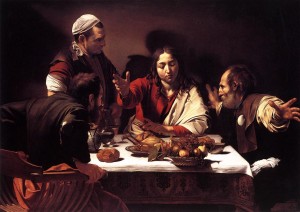Caravaggio: The Supper at Emmaus: 1601
We’re looking at the painting of a scene described in the gospel of St Luke. The story is that two apostles were travelling from Jerusalem when they encountered a stranger on the road.
It was the morning of the third day after Christ’s crucifixion and it had been discovered that the tomb was empty and someone had seen a vision of angels announcing that Jesus was alive. This was – obviously – the talk of Jerusalem, so the apostles were surprised that the stranger seemed to know nothing about this.
The three of them carried on walking and talking until they came to Emmaus, and the two apostles invited the stranger to eat with them. As the stranger blessed the bread, the two apostles recognised him as Jesus himself, risen from the dead – and at that moment Christ disappears.
Caravaggio has captured that instant when the apostles recognise Jesus – and their realisation that they are witnessing a miracle. The chap on the right has thrown his arms wide in surprise, while the one on the left is about to lift himself out of his chair. The innkeeper, standing, doesn’t know quite what’s going on.
The painting seems to break out of the frame. Caravaggio limits the depth of the scene with the characters close to a wall, which works to push everything out towards us – the apostle’s hands intrude into our space, the bowl of fruit teeters precariously and looks as if it is going to spill on the floor – our floor – the elbow of the other apostle pushes out towards us. Everything seems very real indeed.
This is typical of Caravaggio – the extreme realism, the capturing of the moment. He is known to have painted directly onto the canvas rather than making preliminary sketches, and that helps the immediacy of the image. Also typical is the use of the darkness and the shadows of the room with the main details illuminated by a single source of light (a technique known as “chiaroscuro”). Also, look at the characters in the painting – these are believably real people, not ‘pretty’ models. Caravaggio’s saints – even his Christ – look like workers, people who have seen the world.
This worldliness is also reflected in Caravaggio’s life. By the time this picture was painted he had a reputation as a powerful artist – but also as a dangerous character. He had been arrested for street brawls, for fights and assaults, for damaging property. This culminated with him killing a man in a fight in 1606 and being forced to flee Rome where he was working. He went first to Naples, then to Malta, then to Sicily, then back to Naples. He was continuing to paint great religious works during all this time, but he seems always to have been in trouble – either his own doing or by enemies out to get him. He was thrown out of Malta for example, and wounded in a murder attempt in Naples.
In 1610 it seemed like his Roman patrons had managed to get him a pardon, but he never made it back to the city. He was in Porto Ercole in Tuscany and had put all his possessions on the boat to Rome, when he was arrested again. When he got out the ship – and all his stuff – had sailed, so he set off walking to Rome. On the way he caught a fever and died. He was only 38 years old.


